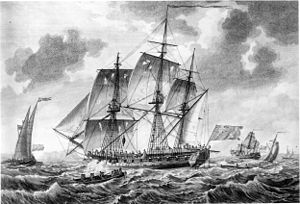
The Coventry-class frigates were 28-gun sixth rate frigates of the Royal Navy, principally in service during the Seven Years' War and the American Revolutionary War. They were designed in 1756 by Britain's Surveyor of the Navy, Sir Thomas Slade, and were largely modeled on HMS Tartar, which was regarded as an exemplar among small frigates due to its speed and maneuverability. The 1750s were a period of considerable experimentation in ship design, and Slade authorized individual builders to make "such alterations withinboard as may be judged necessary" in final construction.

The Bellona-class ships of the line were a class of five 74-gun third rates, whose design for the Royal Navy by Sir Thomas Slade was approved on 31 January 1758. Three ships were ordered on 28 December 1757, with names being assigned on 1 February 1758. Two further ships to this design were ordered on 13 December 1758, at the same time as two ships of a revised design – the Arrogant class.

The Dublin-class ships of the line were a class of seven 74-gun third rates, designed for the Royal Navy by Sir Thomas Slade.

HMS Dublin was a 74-gun third rate ship of the line of the Royal Navy, built by Adam Hayes at Deptford Dockyard and launched on 6 May 1757.

The Ramillies-class ships of the line were a class of nine 74-gun third rates, designed for the Royal Navy by Sir Thomas Slade.

HMS Edgar was a 60-gun fourth rate ship of the line of the Royal Navy, launched on 16 November 1758 at Rotherhithe. The physician Thomas Denman served on Edgar until 1763. She was sunk as a breakwater in 1774.

The Intrepid-class ships of the line were a class of fifteen 64-gun third rates, designed for the Royal Navy by Sir John Williams. His design, approved on 18 December 1765, was slightly smaller than Sir Thomas Slade's contemporary Worcester-class design of the same year, against which it was evaluated competitively. Following the prototype, four more ships were ordered in 1767–69, and a further ten between 1771 and 1779.
The Mermaid-class frigates were a group of six 28-gun sailing frigates of the sixth rate designed in 1760 by Sir Thomas Slade, based on the scaled-down lines of HMS Aurora.

The Enterprise-class frigates were the final class of 28-gun sailing frigates of the sixth-rate to be produced for the Royal Navy. These twenty-seven vessels were designed in 1770 by John Williams. A first batch of five ships were ordered as part of the programme sparked by the Falklands Islands emergency. Two ships were built by contract in private shipyards, while three others were constructed in the Royal Dockyards using foreign oak.
The Southampton-class frigates were 32-gun sailing frigates of the fifth rate produced for the Royal Navy. They were designed in 1756 by Sir Thomas Slade, and were the first 'true' fifth-rate frigates produced to the new single-deck concept. They were, however, designed with sweep ports along the lower deck.
The Richmond-class frigates were 32-gun sailing frigates of the fifth rate produced for the Royal Navy. They were designed in 1756 by the Navy's Surveyor, William Bately, and were his equivalent of the Southampton-class frigates designed by Bately's co-Surveyor, Thomas Slade. They were faster ships than the Southamptons, and were weatherly craft, remaining dry even in high seas. Three ships were ordered to this design between 1756 and 1757, while a second batch of three ships was ordered between 1761 and 1762 to a slightly modified design.

The Roebuck-class ship was a class of twenty 44-gun sailing two-decker warships of the Royal Navy. The class carried two complete decks of guns, a lower battery of 18-pounders and an upper battery of 9-pounders. This battery enabled the vessel to deliver a broadside of 285 pounds. Most were constructed for service during the American Revolutionary War but continued to serve thereafter. By 1793 five were still on the active list. Ten were hospital ships, troopships or storeships. As troopships or storeships they had the guns on their lower deck removed. Many of the vessels in the class survived to take part in the Napoleonic Wars. In all, maritime incidents claimed five ships in the class and war claimed three.

HMS Aquilon was a 28-gun Coventry-class sixth-rate frigate of the Royal Navy. Launched in 1758, she saw active service against the French during the Seven Years' War, capturing seven enemy vessels in the first eight months of 1761. She was declared surplus to Navy requirements and sold into private hands in 1776.
The Temple class ships were two 68-gun third rates designed for the Royal Navy to the lines of the Vanguard of 1748, i.e. to the outdated 1745 Establishment. The Temple class ships were the last 68-gun ships to be built - both by commercial contract - to the draught specified by the 1745 Establishment.
HMS Siren was a sixth-rate post ship of the British Royal Navy, in commission between 1745 and 1763, seeing action during the War of the Austrian Succession and the Seven Years' War.

The Bordelois class was a class of 56-gun ships of the line, designed by Antoine Groignard. This was a unique type, designed to provide a battlefleet armament on a hull able to operate in the shallow waters around Dunkirk. The ships were funded by don des vaisseaux donations and rushed into production for the Seven Years' War, but were completed too late to take part in the conflict. The Flamand would later have a distinguished career during the War of American Independence.

Adam Hayes (1710–1785) was an English 18th century shipbuilder to the Royal Navy. A great number of his models survive.
HMS Sapphire was a 32-gun Royal Navy frigate launched in 1758 to serve in the Seven Years' War.
Israel Pownoll (c.1710–1779) was an English shipbuilder for the Royal Navy.












